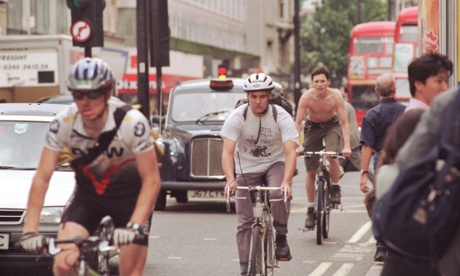
I’m a terrifically nervous cyclist. I never took a cycling proficiency test at school, because I didn’t have a bike, so while everyone else was out weaving between traffic cones on the playground, I had to spend my afternoons sitting inside a knackered old portakabin colouring in pictures of dinosaurs. As a result, I convinced myself that I’d be scraped out from underneath a lorry’s mudguard within 10 seconds if I ever did anything as dumb as putting my bum on a saddle.
It doesn’t help that the common perception of inner city cycling is that, in terms of safety, it’s up there alongside bouncing a glass spacehopper across a minefield full of poisonous snakes and rusty nails. Until the day I visited Cycle Training UK – a not-for-profit co-operative tucked deep inside a former biscuit factory in Bermondsey – I hadn’t been on a bike for two years, when I cycled around a Hebridean island that probably only had a dozen cars on it. Even then, though, I still managed to comprehensively brick myself silly whenever anything overtook me. So the thought of cycling in London, where there are thousands of cars, each containing a driver who’s been pushed to the brink of murderous rage by non-stop exposure to LBC, genuinely filled me with dread.
Fortunately for me, my instructor David Dansky was the universe’s most patient man. He’s been training cyclists since 1998, and had the calm air of someone who’s dealt with every single permutation of terrified novice out there. Before we even touched a bike, he sat me down and explained how our session would progress – he asked what my goals were (mainly not being such a knock-kneed wussbag on the road) and reassured me that we wouldn’t do anything I wasn’t entirely comfortable with. After that, we hit the road. Well, not the road. The car park. David needed to make sure that I didn’t need stabilisers or anything first. Baby steps.
Eventually, we gingerly ventured out into a side street. Before my session, I was convinced that all drivers would instinctively want to murder me. This is because I’ve met me and to some extent can see their point. However, David explained that this fear was exactly what was putting me in danger. If I apologetically clung to the side of the road in the way that all my instincts told me to do, I’d be much more likely to slam into an open car door or drift into a HGV’s blind spot. My crippling reluctance to make eye contact with other drivers – presumably in case I caught them slowly running their finger across their throat at me – had to go, too. You look at drivers to make sure they’ve noticed you. It actually helps you stop being dead.
Instead I needed to be bright and bold, aware of my surroundings but not in fear of them. Cycling in the city is all about minimising risk, and a good way to do that is to understand that you’re a road user too. I deserved to be on that road. I was a person too.
Once this shamefully Oprah-esque lesson had sunk in, everything suddenly became so much easier. We quickly progressed through left-turns and right-turns and junctions, and before I knew it we were on a multi-lane stretch of road barrelling towards a busy roundabout. This was a madness of multitasking – signalling, changing lanes, trying to make eye-contact with drivers, holding your nerve, trying not to scream like a child – but I did it. Admittedly I couldn’t stop swearing under my breath because I was convinced that these would be my final moments on Earth, but I did it. And it was easier the next time I tried it. And the next time.
Even though I was only on the road for a couple of hours, I still managed to get an idea of how disliked cyclists generally are. Almost as soon as I got onto a road, I was aggressively beeped at by the sort of pointlessly white Ranger Rover that only drug dealers and high-level hairdressers drive. I’m pretty sure we got yelled at, too. Cycle Training UK likes to promote mutual understanding – they get drivers on to bikes and cyclists into trucks, to learn what using the road is like from other perspectives – but it’s clear that cyclists still need to develop thick skins. That’s something I’m going to have to do.
But, for the most part, the other road users were completely respectful. Soon enough, within the relatively safe confines of a bus lane on a stretch where I could pick up some speed, I started to see what the fuss was about. Cyclists get the best of both worlds – they’re faster than pedestrians and expending more calories than motorists – and the city’s peppered with little cycle-only shortcuts that look like a lot of fun to bomb through. Before long, I started imagining how great it’d be if I could cycle everywhere myself.
And I think I might start doing that. The lesson was brilliant and alll I want to do now is get a bike. I’m starting to resent having to walk or use public transport, because I know how liberating and exhilarating cycling can be. The course hasn’t made me an amazing cyclist, but it made me more confident, and that’s half the battle. Who knows, with six or seven months of regular practice, I might even stop pleading with God to let me live every time I see a junction.
You can contact Cycle Training UK through their website: cycletraining.co.uk
Interested in finding out more about how you can live better? Take a look at this month's Live Better Challenge here.
The Live Better Challenge is funded by Unilever; its focus is sustainable living. All content is editorially independent except for pieces labelled advertisement feature. Find out more here.

